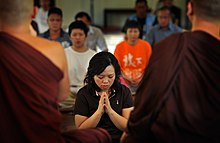
Back Гахапати Bulgarian গৃহস্থ (বৌদ্ধধর্ম) Bengali/Bangla Lægbuddhist Danish गहपति Hindi Háztulajdonos (buddhizmus) Hungarian Perumah tangga (Buddhisme) ID Gahapati Italian 居士 Japanese Cư sĩ Vietnamese 居士 Chinese
| Translations of householder | |
|---|---|
| Sanskrit | gṛhin, gṛhastha, gṛhapati |
| Pali | gihin, gahattha, gahapati |
| Chinese | 居士 |
| Indonesian | perumah tangga |
| Japanese | 居士 |
| Khmer | គ្រហស្ថ (Kror Hors) |
| Mon | ဂရှ် ([həròh]) |
| Sinhala | ගිහි |
| Tibetan | khyim-pa |
| Tamil | இல்லறம் |
| Tagalog | maybahay |
| Thai | คฤหัสถ์ (RTGS: kha rue hat) |
| Vietnamese | Cư sĩ |
| Glossary of Buddhism | |

In English translations of Buddhist texts, householder denotes a variety of terms. Most broadly, it refers to any layperson, and most narrowly, to a wealthy and prestigious familial patriarch.[1] In contemporary Buddhist communities, householder is often used synonymously with laity, or non-monastics.
The Buddhist notion of householder is often contrasted with that of wandering ascetics (Pali: Pāḷi: samaṇa; Sanskrit: śramaṇa) and monastics (bhikkhu and bhikkhuni), who would not live (for extended periods) in a normal house and who would pursue freedom from attachments to houses and families.
Upāsakas and upāsikās, also called śrāvakas and śrāvikās - are householders and other laypersons who take refuge in the Three Jewels (the Buddha, the teachings and the community) and practice the Five Precepts. In southeast Asian communities, lay disciples also give alms to monks on their daily rounds and observe weekly uposatha days. In Buddhist thought, the cultivation of ethical conduct and dāna or "almsgiving" will themselves refine consciousness to such a level that rebirth in one of the lower heavens is likely even if there is no further "Noble" Buddhist practice (connected with the Supramundane goal of Nibbana, "Unbinding"). This level of attainment is viewed as a proper aim for laypersons.[2]
In some traditional Buddhist societies, such as in Myanmar and Thailand, people transition between householder and monk and back to householder with regularity and celebration as in the practice of shinbyu among the Bamar people.[3] One of the evolving features of Buddhism in the West is the increasing dissolution of the traditional distinction between monastics and laity.
For all the diversity of Buddhist practices in the West, general trends in the recent transformations of Buddhist practice ... can be identified. These include an erosion of the distinction between professional and lay Buddhists; a decentralization of doctrinal authority; a diminished role for Buddhist monastics; an increasing spirit of egalitarianism; greater leadership roles for women; greater social activism; and, in many cases, an increasing emphasis on the psychological, as opposed to the purely religious, nature of practice.[4]
- ^ In regards to the narrower definition of what today is often translated from the Pali Canon as "householder," see, for instance, the description of gṛhaspati in Nattier (2003), pp. 22-25. For more information, see Note 3 below.
- ^ Stewart McFarlane in Peter Harvey, ed., Buddhism. Continuum, 2001, pages 195-196.
- ^ In Buckley (2007), a BBC News article describing Burma's monks, the subheading includes: "...even those who do not choose to become a 'career monk' usually enter the orders for short periods of their lives...." In addition, the article's initial source is a BBC Burmese service professional who mentions that during his adult life he himself entered monastic life three times, each time for a few weeks.
- ^ Alan Wallace (2002). Prebish, Charles S. (ed.). Westward dharma : Buddhism beyond Asia (PDF). Berkeley [u.a.]: University of California Press. p. 35. ISBN 0-520-22625-9. Archived from the original (PDF) on 2006-10-10. Retrieved 2006-09-23.